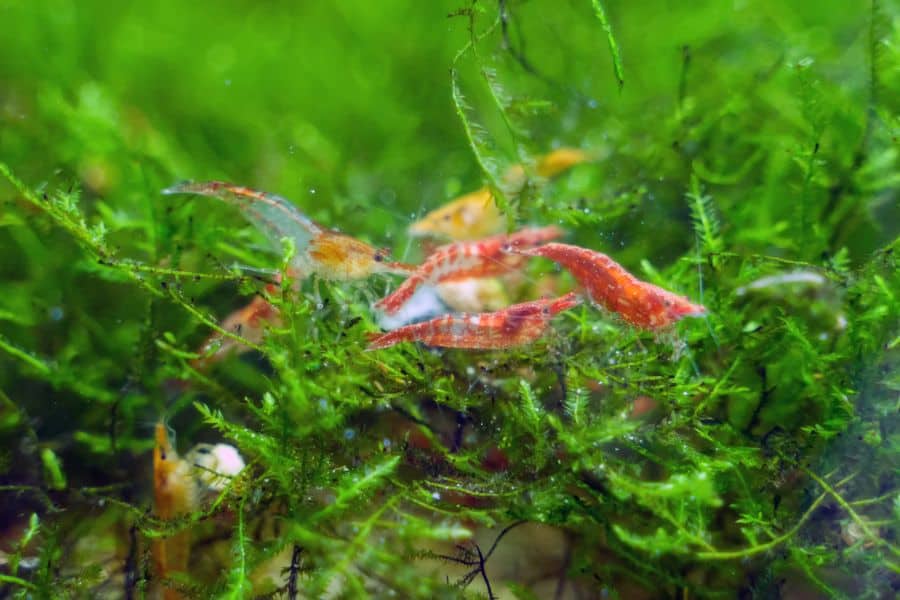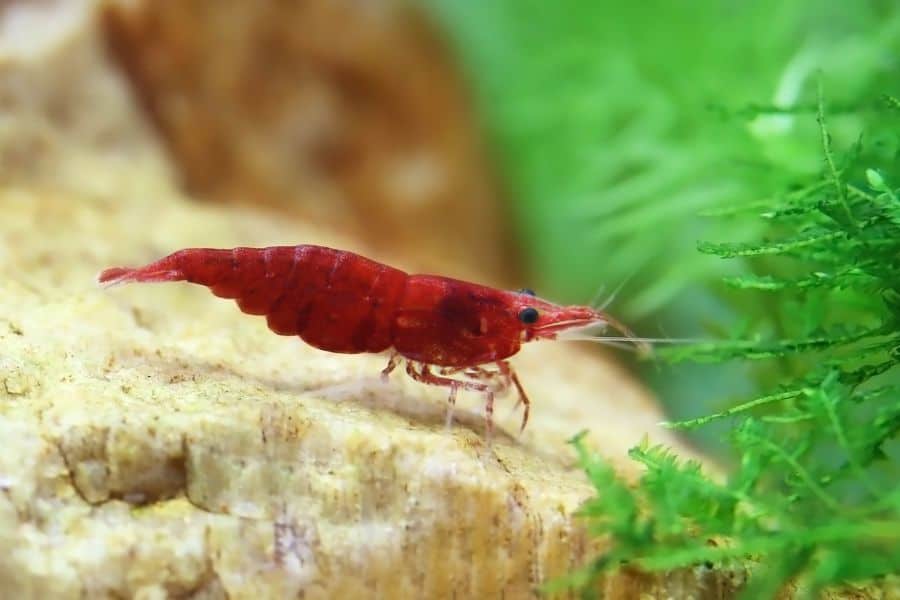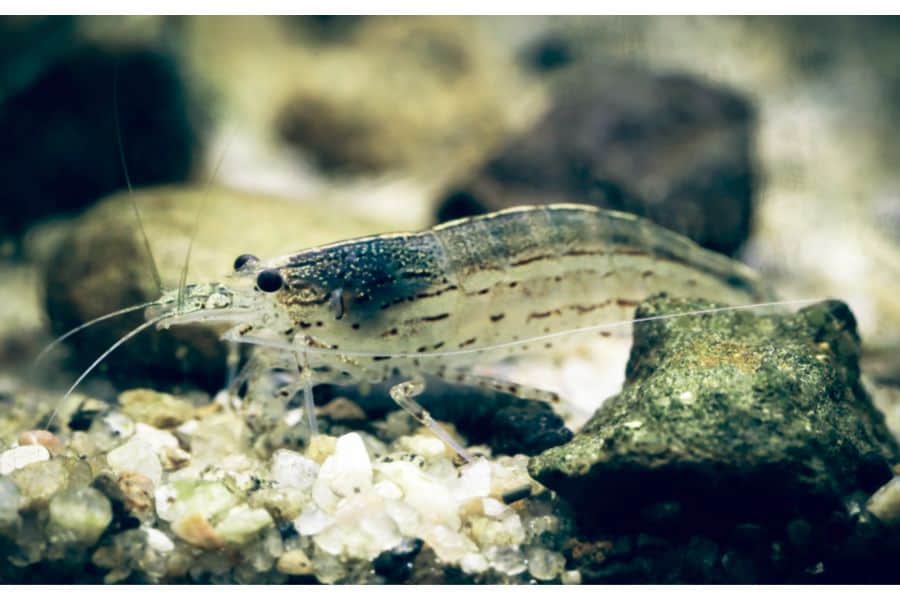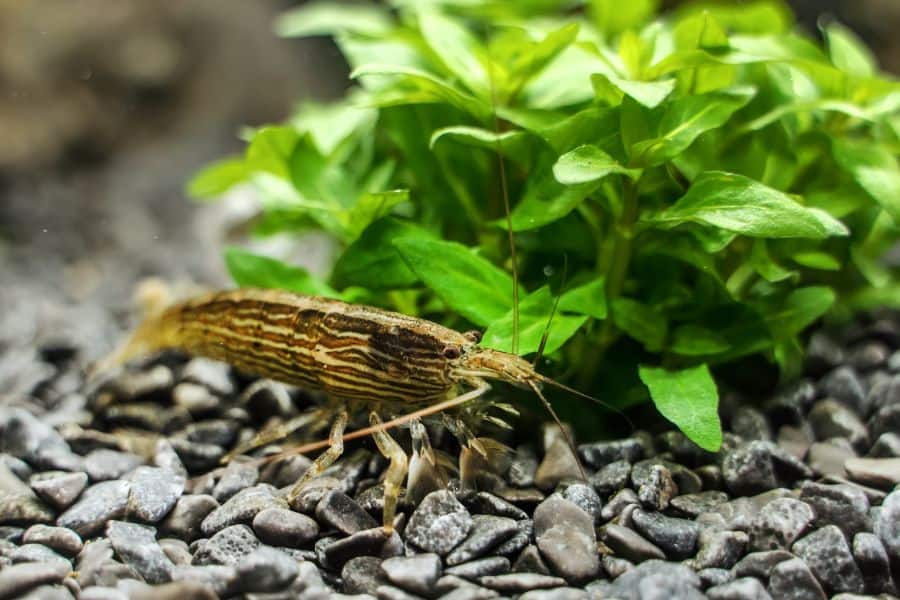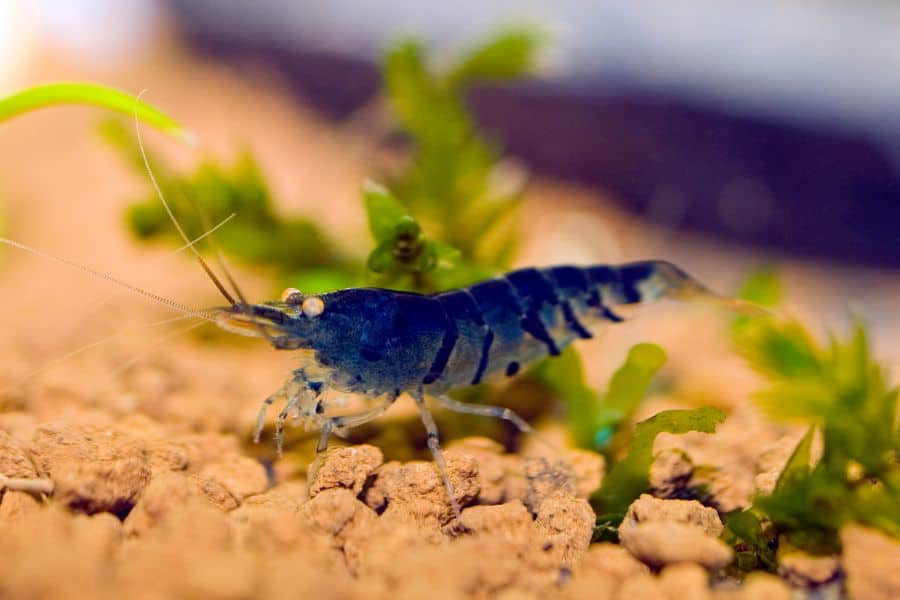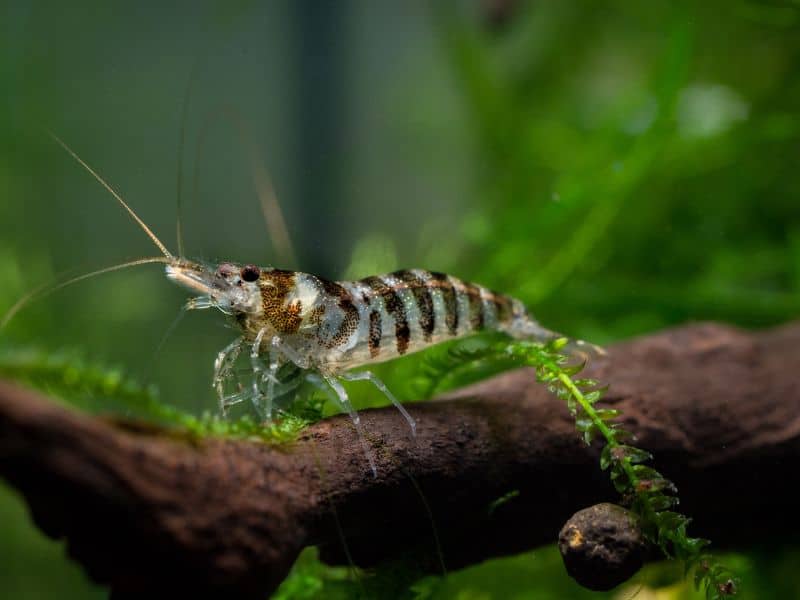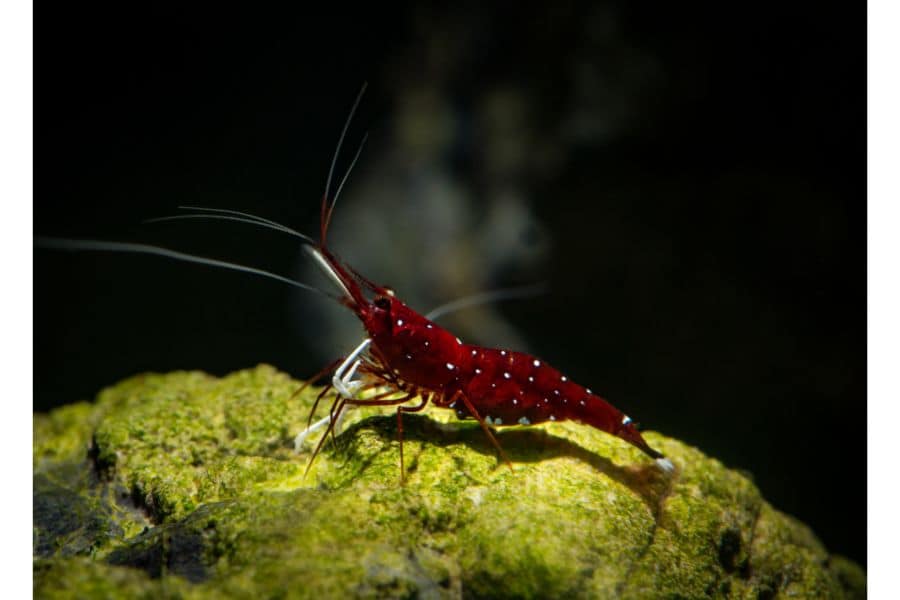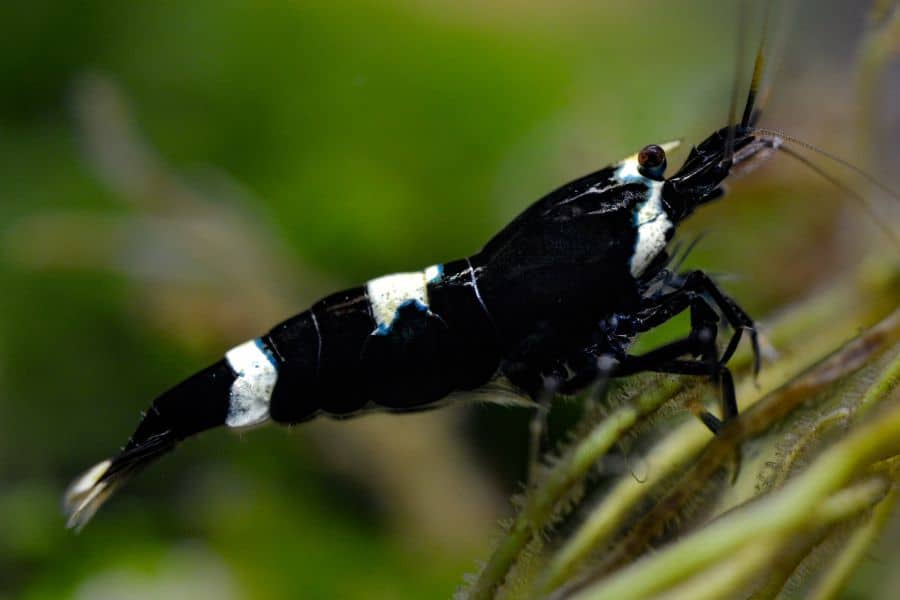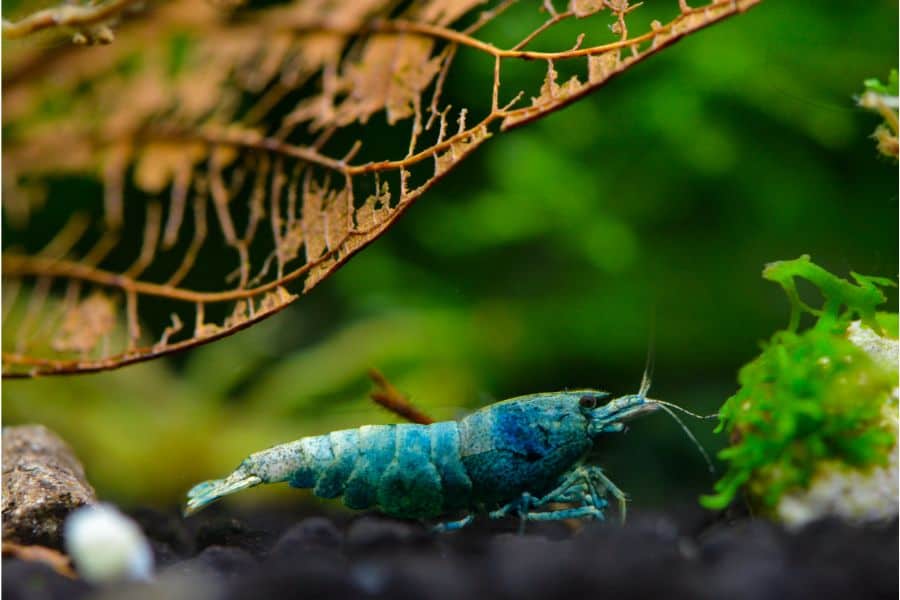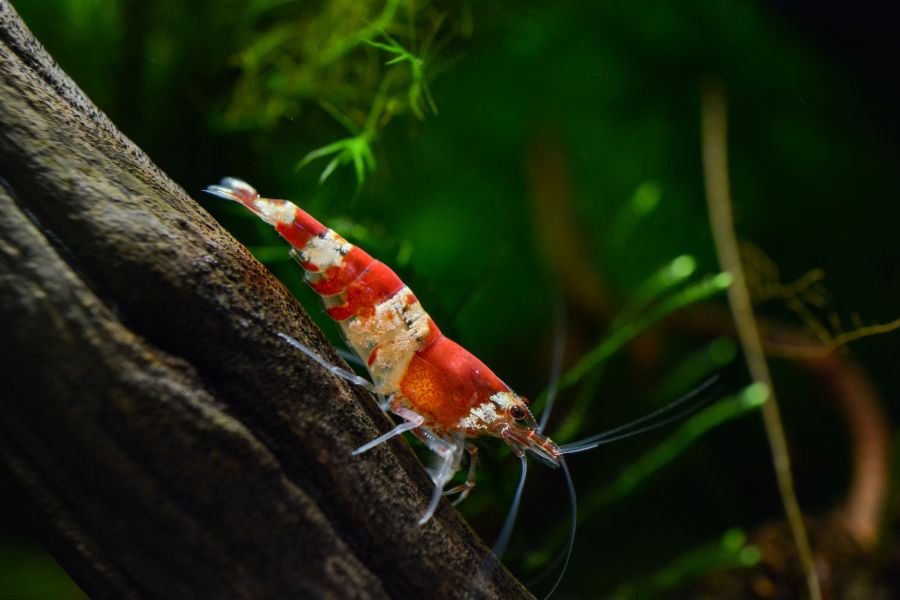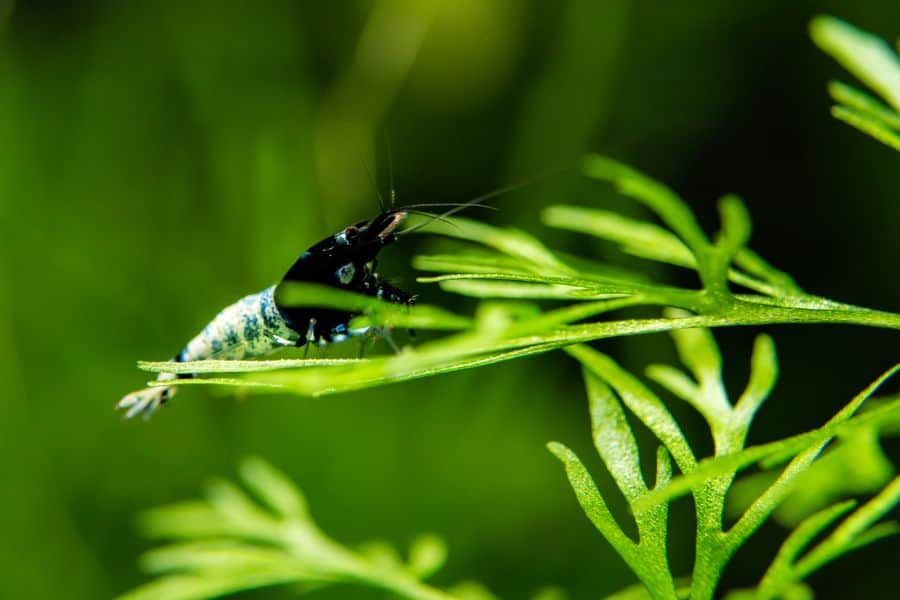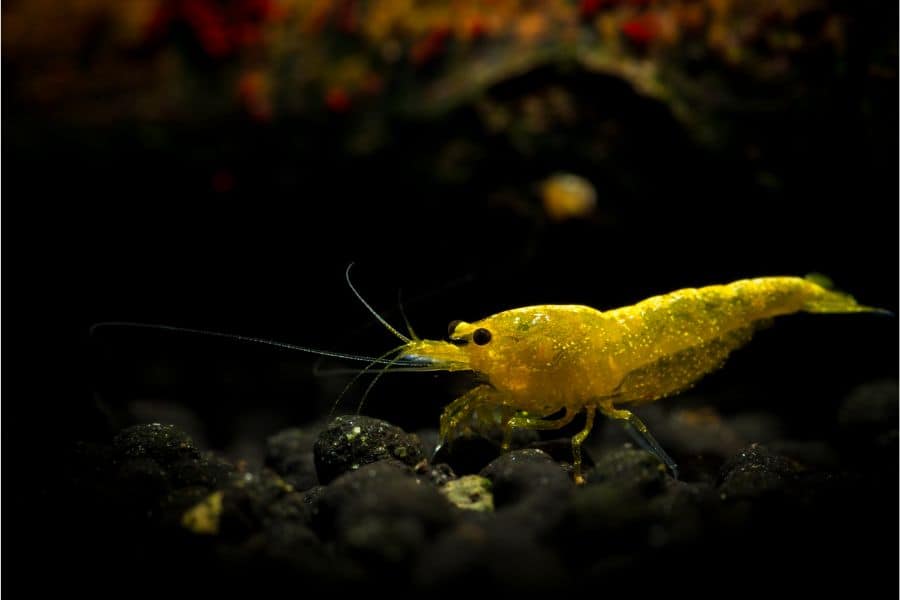One of the best things about the aquarium hobby is the number of things you can do with your biosphere. With proper planning and execution, you can easily create a biosphere for other delightful aquatic creatures, such as aquarium shrimps.
Shrimps offer a unique aesthetic feel to your tank. They’re also very easy to care for and can be very rewarding to keep. But the world of aquarium shrimps is vast. There are hundreds of varieties available, all with their ideal tank parameters and special considerations.
Just like keeping aquarium fishes, you need proper knowledge when preparing your aquarium to accommodate these enjoyable invertebrates. So, in this article, we will discuss the most popular types of aquarium shrimp to help you plan!
Aquarium Shrimp Types Overview
Before we get into the nitty gritty of these critters, there are some things that you should know.
First, don’t be confused with all the different names the display has. While there are hundreds of different varieties with names like Cherry Red and Red Rili, Blue Bolt, and Blue Dream, most shrimps kept in the aquarium only belong to three species: the following.
- Caridina like the crystal shrimp
- Neocaridina like the red cherry shrimp
- Palaemonetes like the ghost shrimp
There are more, of course, but those three are the majority.
More than that, the differences between the three can sometimes be very difficult to point out. For example, the difference between Caridina and Neocaridina remains conflicting and unclear.
However, many varieties of the same species are on the market. These shrimps are bred for special characteristics, such as their coloration, shape, etc.
Those different varieties or types are what we’re going to talk about in this article.
16 Types of Aquarium Shrimp
Let’s look at 16 of the most popular aquarium shrimps around!
1. Cherry Shrimp
- Scientific name: Neocaridina davidi
- Care Difficulty: Easy
- Special characteristics: Deep red color
- Adult Size: Up to 1.5 inches
- Ideal Minimum Tank Size: 5 gallons
- Water hardness: Hard water
- KH: 3-15dKH
- Temperament: Very timid
- Heater: No
One of the most popular shrimp types is the cherry shrimp, also called red cherry shrimp.
These shrimps have a compact and rounded shape, with a strikingly vibrant red body that makes them stand out in any aquarium. This stunning color is a reason that will lend a visual spectacle to any aquarium – but aside from their color, there are more reasons to love the cherry shrimp.
The top reason is perhaps their ease of care. They’re well-suited for beginners and experienced aquarists alike since they can thrive in a wide range of parameters compared to other, more fragile shrimp species.
They thrive best in well-established freshwater aquariums with stable water parameters and plenty of natural hiding spots. That said, they’re prone to hiding among greenery and decorations for days due to
2. Amano Shrimp
- Scientific name: Caridina multidentata
- Care Difficulty: Easy
- Special characteristics: Good algae eater
- Adult Size: 2 inches
- Ideal Minimum Tank Size: 10 gallons
- Water hardness: Soft water
- KH: 1-10dKH
- Temperament: Peaceful
- Heater: No
Amano Shrimp feature a translucent body with a distinctive swathe and dark spots along their bodies. They have a unique appearance with a slightly curved back, making them easily recognizable.
Amano Shrimp are highly sought after for their exceptional algae-eating abilities. They are efficient cleaners, making them valuable to planted and well-lighted aquariums. They’re also peaceful and can coexist with practically anything that doesn’t eat or harass them.
That said, Amano shrimp can be difficult to breed. They follow a complex life cycle where they are born in the ocean but swim into brackish freshwater to become adults. Thus, you wouldn’t want to put them in a tank where they will be eaten because they won’t reproduce independently.
In terms of care, the Amano Shrimp are hardy and adaptable. They might not have the same flashy appearance as many others in their species, but they have an unbeatable natural look, easy care requirements, and have a useful role in the aquarium.
3. Ghost Shrimp
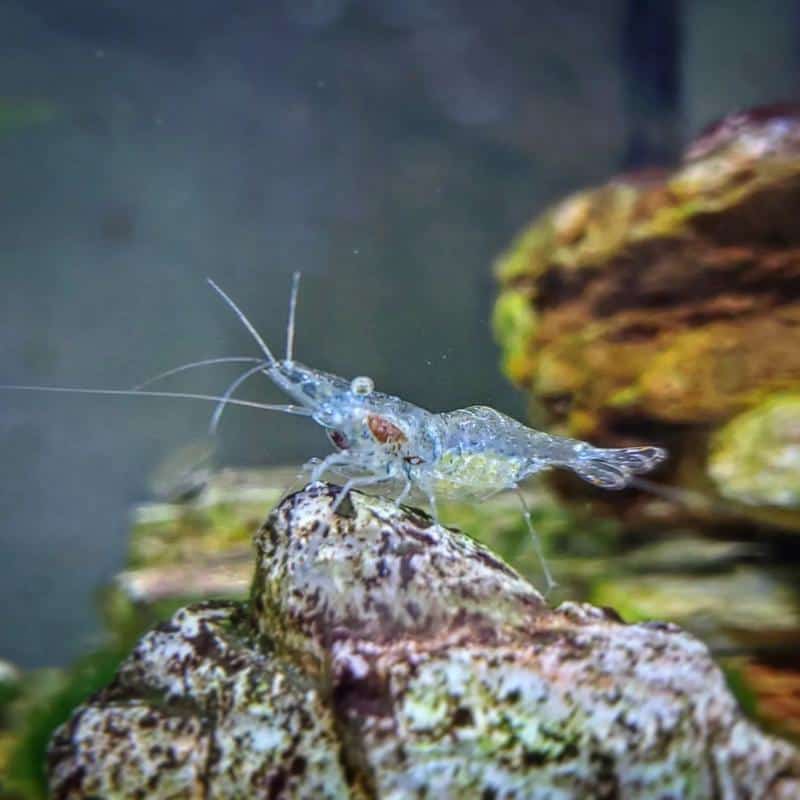
- Scientific name: Palaemonetes paludosus
- Care Difficulty: Easy
- Special characteristics: Hardiness and tank cleaning abilities
- Adult Size:5 inches
- Ideal Minimum Tank Size: 5 gallons
- Water hardness: Slightly hard
- KH: 3-15dKH
- Temperament: Peaceful
- Heater: No
Ghost Shrimp, also known as Glass Shrimp or eastern grass shrimp, has a translucent body that resembles glass, allowing you to see their internal organs. This acts as a natural camouflage and makes them difficult to see, especially in planted aquariums.
They’re extremely popular among aquarists, particularly beginners. Ghost shrimp are undemanding and can tolerate many water parameters, making them suitable for many freshwater setups. More than that, they also eat algae and can help keep the tank clean.
They also don’t have the same breeding requirements as the Amano shrimp. They can easily breed in tanks and have been known to multiply even without intervention. Because of that, these species are also often used as feeders for predatory fishes.
4. Bamboo Shrimp
- Scientific name: Atyopsis moluccensis
- Care Difficulty: Easy
- Special characteristics: Pattern and size
- Adult Size: 2 – 3 inches
- Ideal Minimum Tank Size: 10 gallons
- Water hardness: Moderately hard water
- KH: 3 – 10 KH
- Temperament: Peaceful, very timid, semi-aggressive, outgoing (?)
- Heater: No
Bamboo Shrimp, also known as Wood Shrimp or Singapore Flower Shrimp, stand out with their unique fan-shaped appendages to filter feed.
They have a red to brownish coloration and interesting patterns in their main body, making them visually stunning.They can also have marble-like streaks across their body, making their exoskeletons look distinctly wood-like.
They also grow larger than many aquarium shrimps in the hobby, so it’s quite easy to spot them. Interestingly, they also tend to position themselves wherever the water flow is greatest to catch tiny particles from the flow because they are filter feeders.
One caveat about bamboo shrimp is that they’re easily affected by sudden changes in water parameters. Also, they’re also very difficult to breed in the tank, so don’t keep them with aggressive fish.
5. Tiger Shrimp
- Scientific name: Caridina cf cantonensis
- Care Difficulty: Moderate
- Special characteristics: Color
- Adult Size:25 inches
- Ideal Minimum Tank Size: 10 gallons
- Water hardness: Hard water
- KH: 0-2KH
- Temperament: Peaceful
- Heater: No
The tiger shrimp has dozens of variations in circulation, but they all come from this unique-looking species.
Like its namesake, the tiger shrimp has black stripes adorning its body, giving them a wild look. Tiger shrimp are highly sought after for their captivating appearance. The bold contrast of their black stripes makes them stand out in any aquarium, especially densely planted ones.
They can also cross-breed with other Caridina cf cantonensis shrimps. The most popular cross you’ll see in the market is between this and the bee shrimp, resulting in a variety called Tibee (tiger bee).
They can also contribute to the cleanliness of your tank, as they consume detritus, uneaten food, and algae to an extent. However, you’ll need to be wary of water parameters while keeping them because they have strict requirements, and their physiques don’t take kindly to sudden changes.
6. Babaulti Shrimp
- Scientific name: Caridina cf. babaulti
- Care Difficulty: Easy
- Special characteristics: Color-changing abilities
- Adult Size: 1 inch
- Ideal Minimum Tank Size: 5 gallon
- Water hardness: Hard water
- KH: 0-10
- Temperament: Very timid
- Heater: No
One of the newer species of shrimp to be introduced to the aquarium hobby, the Babaulti Shrimp, is still very mysterious and fascinating.
They’re a member of the dwarf shrimp species, which means that they don’t grow to more than an inch in length. They can have wildly different color variations, such as green, brown, blue, and orange. Babaulti shrimp can change their colors when they are breeding, stressed, or depending on the predominant colors of their environment.
However, their most interesting feature is their ability to change color depending on their environment. Babaulti shrimp have a characteristic called chromatic adaptation, which lets them change color like chameleons (which is also why they are called chameleon shrimps).
These shrimp can be very hardy when established but very susceptible to the environment when first introduced to the tank. They can also be timid and will appreciate a lot of cover in your aquarium.
7. Snowball Shrimp
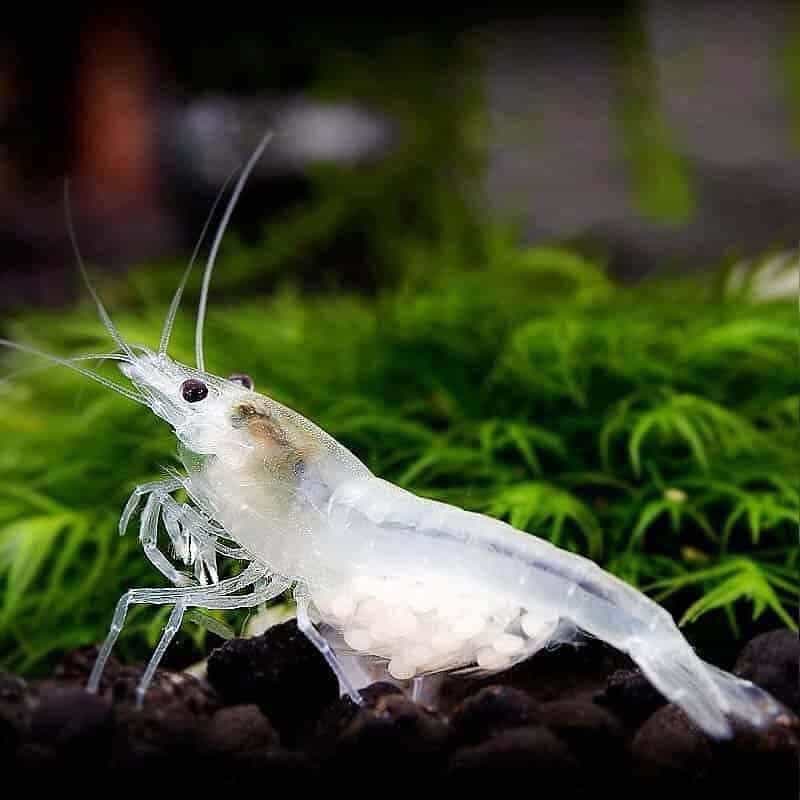
- Scientific name: Neocaridina zhangiajiensis var.
- Care Difficulty: Easy
- Special characteristics: Color and general hardiness
- Adult Size: 1 inch
- Ideal Minimum Tank Size: 5 gallons
- Water hardness: Moderately hard
- KH: 1-8
- Temperament: Peaceful
- Heater: Yes, if in cold climates (65-85 °F)
Snowball shrimp are characterized by their pristine coloration, like tiny snowballs in the aquarium. They have a rounded body and strikingly bright white color, making them a standout addition to any tank.
Snowball shrimps can survive a wide range of water parameters. As long as your tank is fully cycled and clean, snowball shrimps will willingly call it home.
They’re also very easy to breed and, like Ghost shrimps, can easily multiply in your aquarium. This makes them sought after by beginners in the aquarium scene.
Their general hardiness, striking white colors, and easy breeding patterns make them a go-to for those just wanting to populate their tanks with invertebrates.
8. Cardinal Shrimp
- Scientific name: Caridina dennerli
- Care Difficulty: Moderate
- Special characteristics: Size and color
- Adult Size: 1 inch
- Ideal Minimum Tank Size: 5 gallons
- Water hardness: Hard water
- KH: 3 to 10 dKH
- Temperament: Very timid
- Heater: Yes (78–88°F)
This fascinating, rare, and even slightly controversial shrimp is highly popular among experienced shrimp keepers and even more prized by conservationists.
Cardinal shrimp are renowned for their vibrant red coloration, with distinctive white stripes along their body. Their intense red hue and unique dotted white markings make them a prized addition to shrimp tanks.
They’re a focal point in any aquarium, though they can be very timid and will appreciate plenty of hiding spots. Additionally, they’re sensitive to water quality. They’re also sensitive to strong lighting and prefer shaded environments.
Another key thing to note about this shrimp species is that they’re endangered in the wild, placing their conservation a top priority. It’ll be difficult to find Cardinal shrimps for sale and even more difficult to keep – but they’re well worth it.
9. Panda Shrimp
- Scientific name: Caridina cf. cantonensis var. “Panda”
- Care Difficulty: Moderate
- Special characteristics: Color
- Adult Size: 2 inches
- Ideal Minimum Tank Size: 5 gallons
- Water hardness: Moderately hard
- KH: 0-4
- Temperament: Peaceful
- Heater: No
A high-end and popular shrimp breed, panda shrimps are well worth the time and money you pour into them.
Panda shrimp showcase a striking black and white color pattern, resembling a panda bear, hence their name. They also have different variations, including the King Kong panda shrimp, the Red Ruby, and the Blue Panda Shrimps.
This species is very popular among experienced aquarists, as they’re rare and expensive. They’re also as difficult to care for as they are to acquire. They require strict water parameters and don’t tolerate deviations.
Despite that, Panda shrimps can be easy to breed and are known to interbreed with other Caridina species.
10. Vampire Shrimp
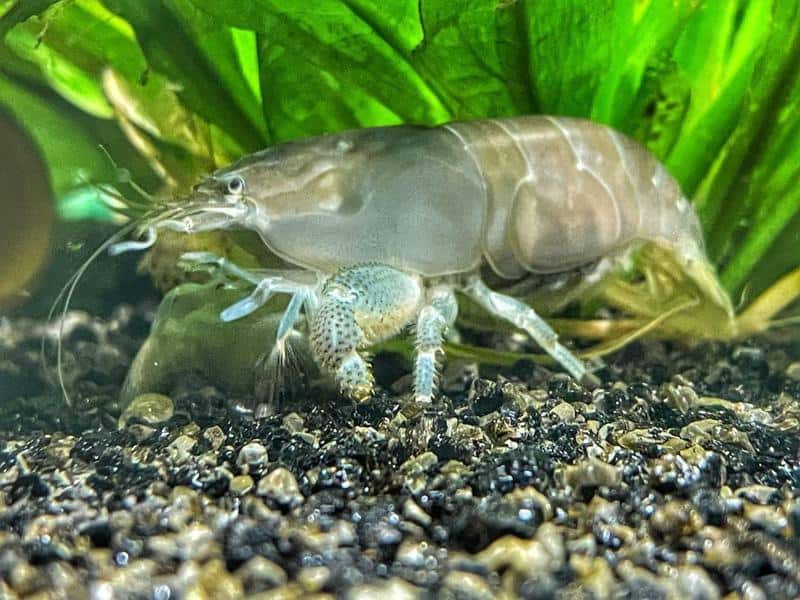
- Scientific name: Atya gabonensis
- Care Difficulty: Moderate
- Special characteristics: Size and appearance
- Adult Size: 3 inches
- Ideal Minimum Tank Size: 15 gallons
- Water hardness: Hard water
- KH: 3 to 10 dKH
- Temperament: Shy and timid
- Heater: Yes (75–84°F)
This visually interesting shrimp species has a unique appearance that draws many hobbyists in. It’s pretty large at 3 inches and can add a visual spectacle to any aquarium. They also have different color variations, such as green, gray, and blue.
But the most interesting part of its appearance is the spikes on its feet that resemble vampire fangs, earning it its name.
Looks can be deceiving though, as vampire shrimps are rather calm and even tend to be very timid. As such, they thrive best in tanks with plenty of organic and hardscape cover and don’t like aggressive tankmates that might harass them.
Plus, as filter feeders, they tend to position themselves in areas with strong currents, such as near powerheads, filters, or the bottom of tanks.
11. Blue Bolt
- Scientific name: Caridina cf cantonensis
- Care Difficulty: Easy
- Special characteristics: Deep blue color
- Adult Size:5 inches
- Ideal Minimum Tank Size: 10 gallons
- Water hardness: Moderately hard
- KH: 0 -1 KH
- Temperament: Peaceful
- Heater: No
Blue Bolt Shrimp are captivating freshwater shrimp known for their intense blue coloration and striking patterns. These stunning invertebrates feature a deep blue hue, often adorned with intricate white or black markings, which adds a vibrant splash of color to any aquarium.
Their appearance makes them highly sought after by shrimp enthusiasts. They’re a prized addition to planted aquariums and aquascapes.
Luckily, ensuring the best care for Blue Bolt Shrimp is relatively easy. Simply maintain stable water parameters, and provide a well-maintained tank with hiding spots and plenty of live plants, as they enjoy exploring and grazing on algae.
This shrimp variety is peaceful and can thrive in a shrimp-only tank or a community tank with other peaceful fishes that won’t harass them, and are thus an excellent choice for beginner hobbyists.
12. Extreme Wine Red
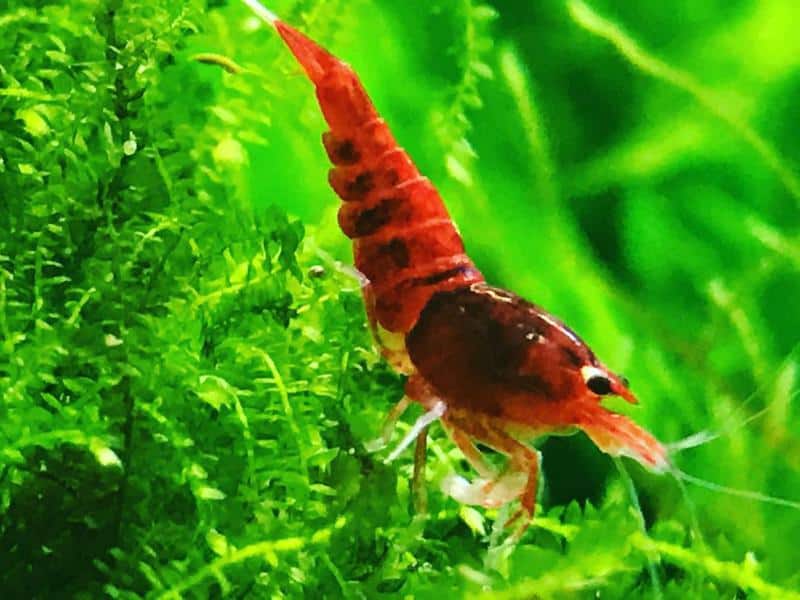
- Scientific name: Caridina cantonensis
- Care Difficulty: Advanced
- Special characteristics: Color
- Adult Size:5 inches
- Ideal Minimum Tank Size: 10 gallons
- Water hardness: Moderately hard
- KH: 0-4
- Temperament: Peaceful
- Heater: No
Another variety of the Caridina cantonensis species, this shrimp is prized for its deep red coloration. Selectively bred for this specific color, this variety will surely draw the eye, no matter your aquarium setup.
Like the other varieties of the Caridina species, this shrimp species is easy to care for. They are generally hardy, and though they have water quality requirements, they also tolerate many conditions.
They’re also fairly easy to breed, having been known to interbreed with other Caridina varieties.
They can be expensive to get, though, as they are prized by hobbyists and breeders for their distinct coloration. But they’re well worth the investment.
13. Red Nose Shrimp
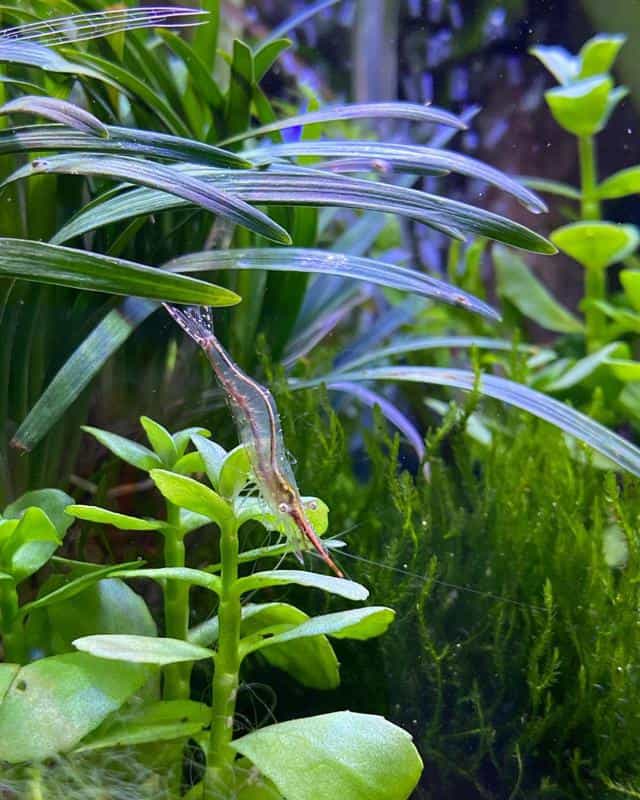
- Scientific name: Caridina gracilirostris
- Care Difficulty: Easy
- Special characteristics: Elongated “nose” or rostrum
- Adult Size:5 inches
- Ideal Minimum Tank Size: 10 gallons
- Water hardness: Hard
- KH: 1 – 10
- Temperament: Peaceful
- Heater: No
Red Nose Shrimp, also known as Pinocchio Shrimp, are charming and distinctive shrimp species known for their unique “nose” or rostrum.
These freshwater shrimp sport a bright red or orange coloration, which is particularly vibrant on their noses, adding to their allure. The elongated rostrum gives them a whimsical and eye-catching appearance reminiscent of Pinocchio’s nose.
Red nose shrimp are also a favorite choice for planted aquariums and nano tanks due to their small size and peaceful nature.
Caring for them is relatively straightforward but can be difficult to execute. They need strict water maintenance and can be adversely affected by sudden changes. They breed easily, although it takes them six months to reach sexual maturity.
14. Bee Shrimp
- Scientific name: Caridina cantonensis
- Care Difficulty: Easy
- Special characteristics: Coloration
- Adult Size: 1 inch
- Ideal Minimum Tank Size: 5 gallons
- Water hardness: Moderately hard
- KH: 0 – 2
- Temperament: Peaceful
- Heater: No
Bee shrimp are adorable and visually interesting shrimp species recognized for their striking black and white striped patterns.
These shrimp varieties exhibit a bee-like appearance, with bold black stripes on a light-colored body, earning them their charming name. They also come in various color variations, including black, red, and yellow, each with its unique visual spectacle.
Their captivating appearance and small size make them a popular choice for shrimp enthusiasts looking to add diversity and visual interest to their tanks.
Bee shrimp are peaceful and can thrive in a community tank with other peaceful shrimp species, making them an excellent choice for aquarists of all experience levels.
15. Pinto Shrimp
- Scientific name: Caridina cantonensis
- Care Difficulty: Intermediate
- Special characteristics: Color and pattern variety
- Adult Size:25 inches
- Ideal Minimum Tank Size: 5 gallon
- Water hardness: Moderately hard
- KH: 0 – 4
- Temperament: Peaceful
- Heater: No
Pinto Shrimp are captivating freshwater shrimp highly prized for their intricate and diverse color patterns. These eye-catching invertebrates exhibit a stunning mosaic of contrasting markings, creating a beautiful marbled effect on their bodies.
The mesmerizing color variations, which resemble artistic brush strokes, have led to their popularity among shrimp enthusiasts and aquascapes.
Pinto Shrimp are generally peaceful and can thrive in a shrimp-only tank or a community tank with other peaceful species. This makes them an excellent choice for any aquarist seeking a visually stunning addition to their aquarium.
16. Yellow Goldenback
- Scientific name: Neocaridina davidi
- Care Difficulty: Easy
- Special characteristics: Color
- Adult Size:25 inches
- Ideal Minimum Tank Size: 5 gallons
- Water hardness: Moderately hard
- KH: 3-15
- Temperament: Peaceful
- Heater: No
Yellow goldenback shrimp are visually striking freshwater shrimp known for their bright yellow coloration and distinctive golden stripe running along their backs.
Their vibrant appearance adds a touch of sunshine to any aquarium, making them an attractive choice for any aquarium setup.
Yellow goldenback shrimp are generally peaceful and can thrive in a shrimp-only tank or a community tank with other peaceful species, making them an excellent choice for aquarists of all levels.
They’re also fairly easy to keep because they can tolerate various conditions. They also breed relatively easily.
Also Read:
FAQs
Why Should You Keep Shrimps in Your Aquarium?
Keeping shrimps is a fun and low-maintenance way to add visual interest to any community aquarium, and they are also fulfilling to keep on their own. Some varieties are also fairly useful and can help clean your tank.
Is Keeping Shrimp Easy?
Like different varieties of fish, there are also different varieties with varying care levels. Some shrimps will be easy to keep, while some will need established tanks that won’t fluctuate.
What Is the Best Shrimp to Keep?
The best shrimp for you to keep is highly subjective and depends on factors such as your experience, equipment, the kind of tank you need, and more. This article provided significant metrics to judge whether or not a shrimp variety will suit your needs.
Conclusion
Shrimps and invertebrates are an entirely different side of the aquarium hobby, with their intricacies. There are many shrimp varieties around, and new shrimp keepers might be overwhelmed with the choices.
In this article, we discussed the most popular shrimps in the market and what makes them such great choices for aquarists of all levels. Now, you have a solid basis to choose your aquarium!
